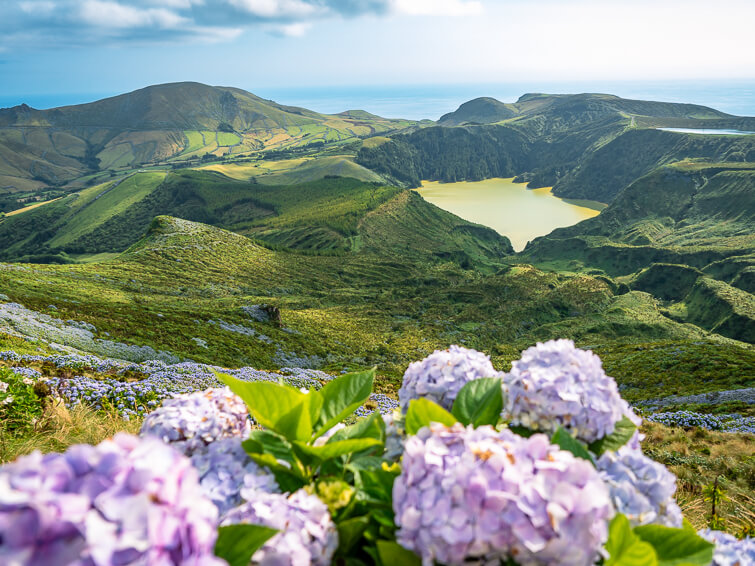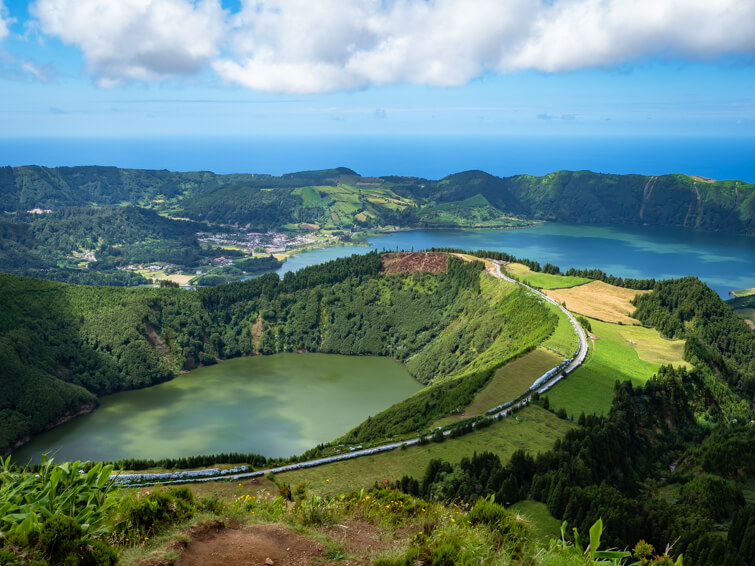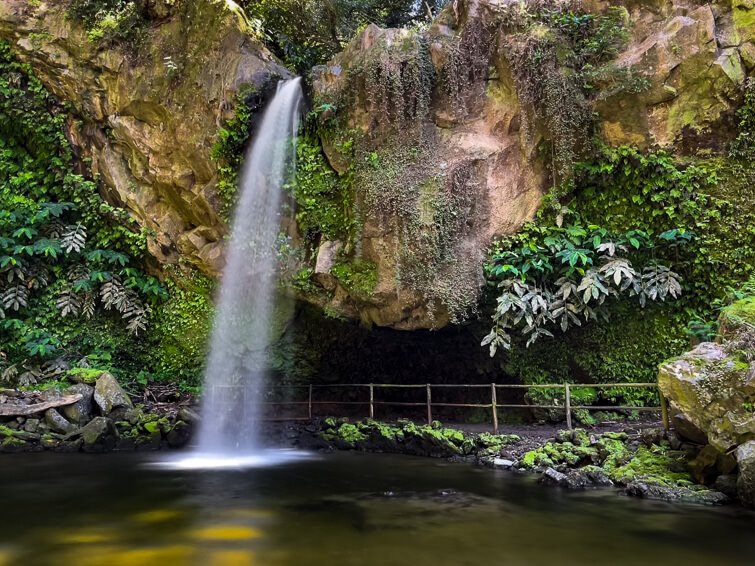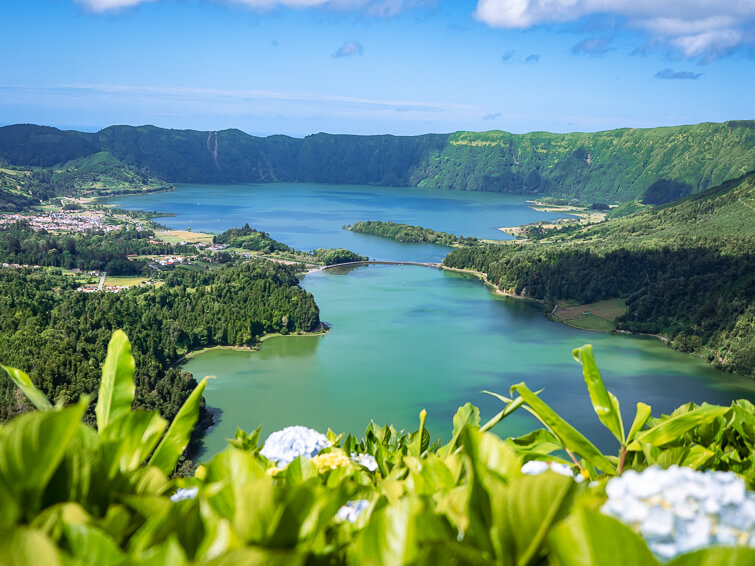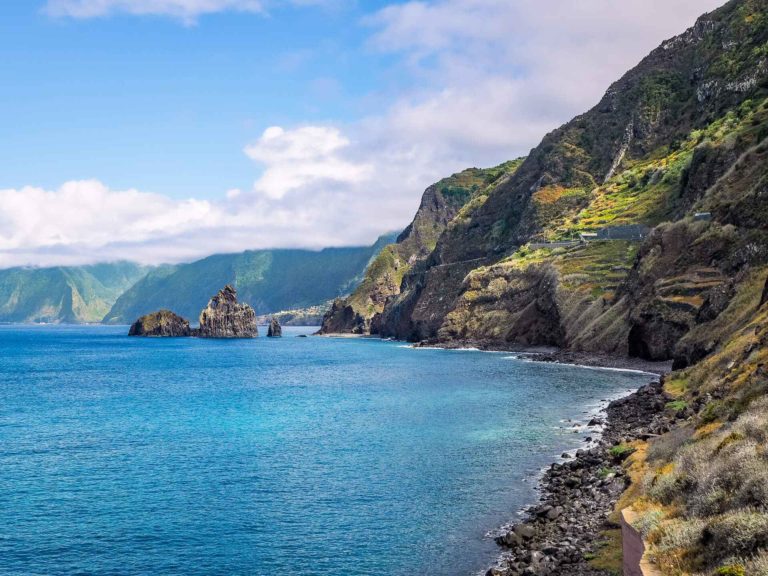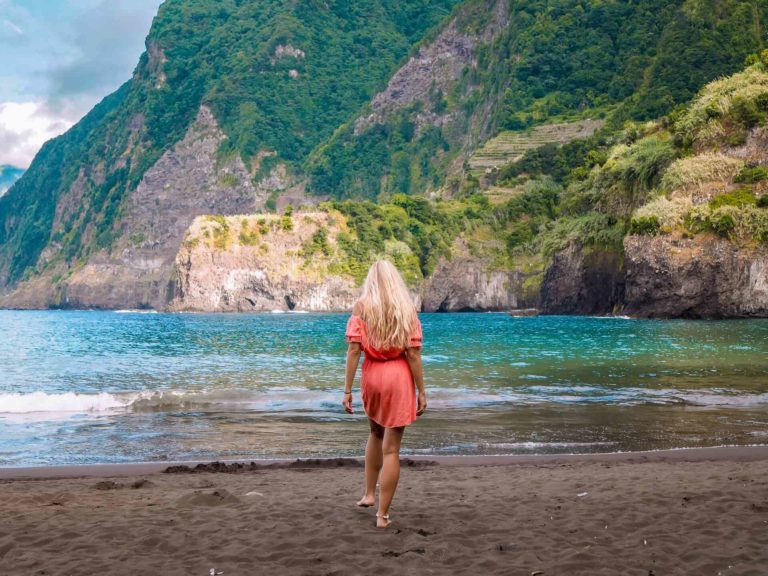Visiting Corvo Island, the most remote island of the Azores
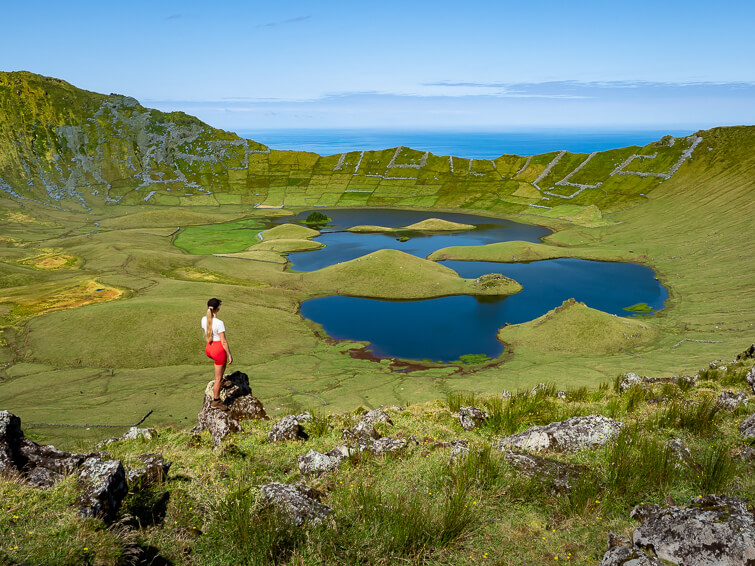
Visiting Corvo Island in the Azores feels like being at the edge of the world. This isolated speck of an island in the Atlantic Ocean is a true hidden gem and has remained untouched by mass tourism despite its natural beauty. If you enjoy remote, unspoiled and tranquil places like I do, you’d love visiting this island.
Corvo is best known for its massive green volcanic crater that dominates the island’s landscape. This natural wonder was the main reason I decided to visit Corvo during my Azores trip and it definitely lived up to my expectations. It was unlike any place I’d ever seen.
Planning a trip to this tiny island is not particularly complicated but there are certain things you should be aware of. In this Corvo travel guide, I’ll take you through everything you need to know to visit the island, including how to get there, top things to do, where to stay, when to visit and more.
Disclosure: This article contains affiliate links from which I may make a commission at no additional cost to you if you make a purchase.
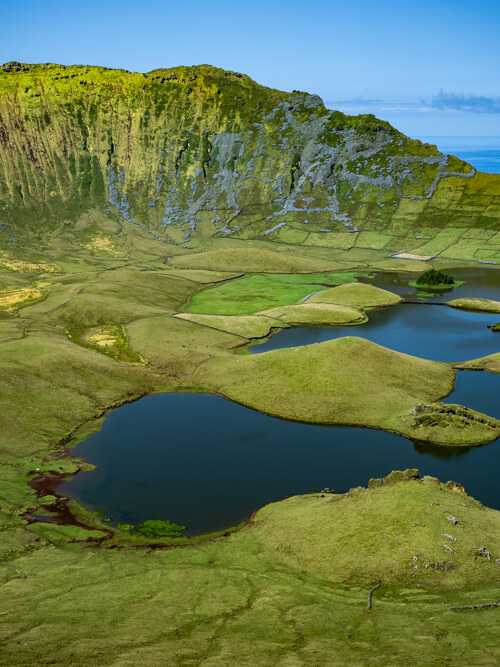
General info about Corvo, Azores
Corvo Island is located in the middle of the North Atlantic Ocean. It’s the northernmost island of the Azores archipelago in Portugal and its name translates to Crow Island in English. With a total area of 17 km² (6.6 sq mi) and a population of roughly 430 people, it’s the smallest island in the Azores.
Even though Corvo is a part of Europe, it actually lies on the North American tectonic plate together with the neighboring Flores Island and is roughly the same distance from Canada as it is from mainland Portugal.
Thanks to Corvo’s great biodiversity and a high number of rare and endemic species (highest in the Azores), the island has been declared a UNESCO Biosphere Reserve.
The only settlement on the island is Vila do Corvo village. It has a small airport, a few restaurants, a hotel, a couple of grocery shops and a port.
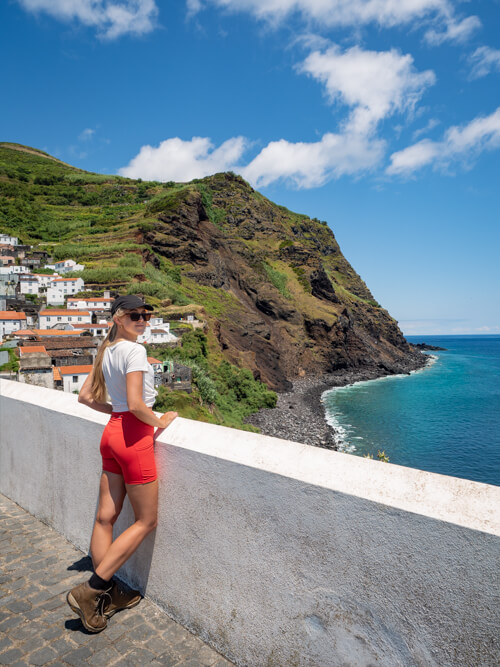
How to get to Corvo Island
There are two ways to get to Corvo – by boat from Flores or by plane from Faial and Flores. The only airline that flies to and from Corvo is the local Azorean airline SATA.
Most people visit Corvo by boat on a day trip from Flores. That’s what we did as well. It’s the best option if you’re short on time and can only dedicate one day to Corvo. You can either take a small ferry by Atlantico Line or a boat tour, which is definitely the more fun way to get to Corvo.
We took this 7-hour boat tour, which not only included stops at sea caves and several beautiful waterfalls along the coast of Flores but we also saw a pod of dolphins very close to our boat! Apparently, dolphin sightings happen often on these tours.
The tour started at 9 am at the port of Santa Cruz das Flores, where we got into our RIB boat. The boat then headed north along the coast of Flores before crossing over to Corvo. We then had about 4.5 hours to spend on Corvo in whichever way we wanted.
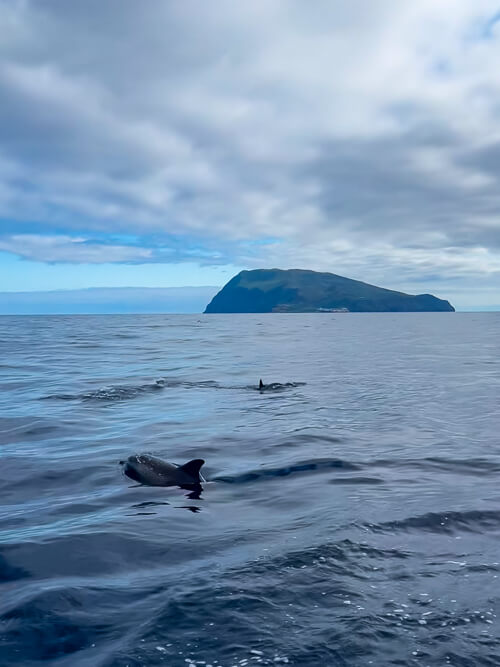
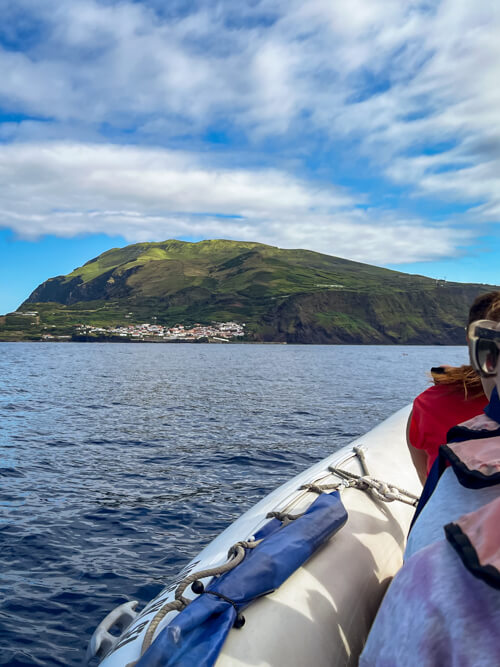
Related posts: If you’re wondering how to plan the rest of your Azores trip, read my post on how to spend 10 days in the Azores. For the best things to do and see on Flores (my favorite Azores Island), check out my detailed Flores travel guide.
Getting around the island
There are no rental cars or public transportation in Corvo so your only ways to get around are by foot, by bike or by local taxis. There simply isn’t any need for buses or rental cars as the island is so small and only has a few roads. If you’d like to rent a bike, you can do that at Joe & Vera’s Bike Rental.
If you’re visiting Corvo on a boat tour like we did, there will be taxis waiting at the port when you arrive.
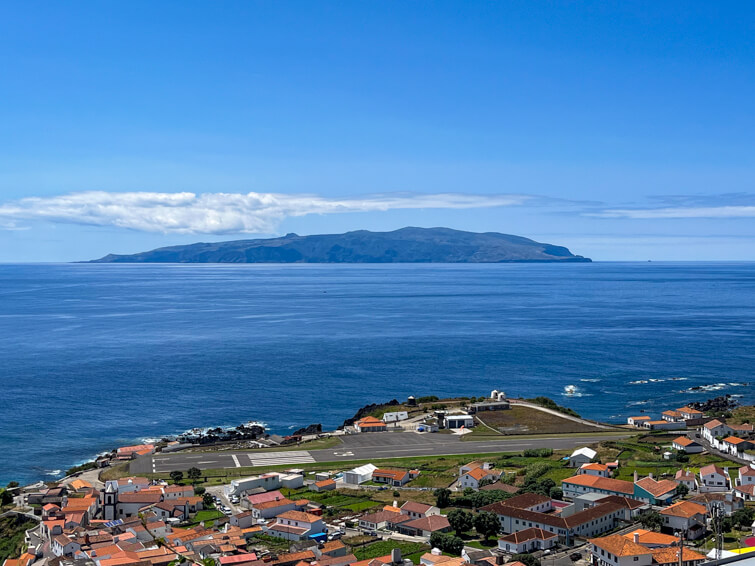
Caldeirão Volcano: The top attraction in Corvo
The Caldeirão Volcano is by far the most famous place to visit in Corvo and the main reason why people travel to this island. The spectacular 2.3-km-wide (1.4 mi) volcanic crater is like a giant bowl containing bright green pastures, volcanic cones, bogs and blue lakes between its steep walls. It’s a surreal landscape that looks as if it belongs to a fantasy movie.
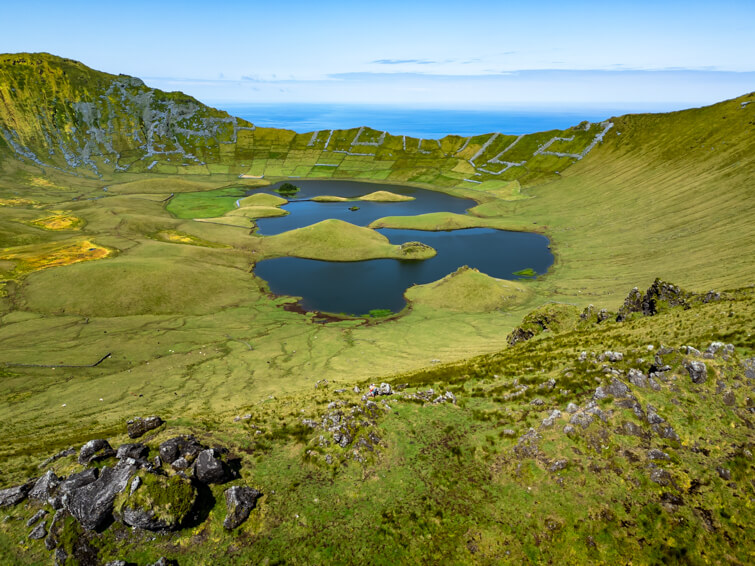
To get to the crater, you have to walk or take a taxi to Caldeirão Viewpoint (Miradouro Caldeirão), which is 6 km (3.7 mi) from Vila do Corvo. The taxi ride costs 10 euros per person for a round trip.
Once at the viewpoint, you can just enjoy the view from there but I highly recommend also hiking around Caldeirão to see the crater from different angles.
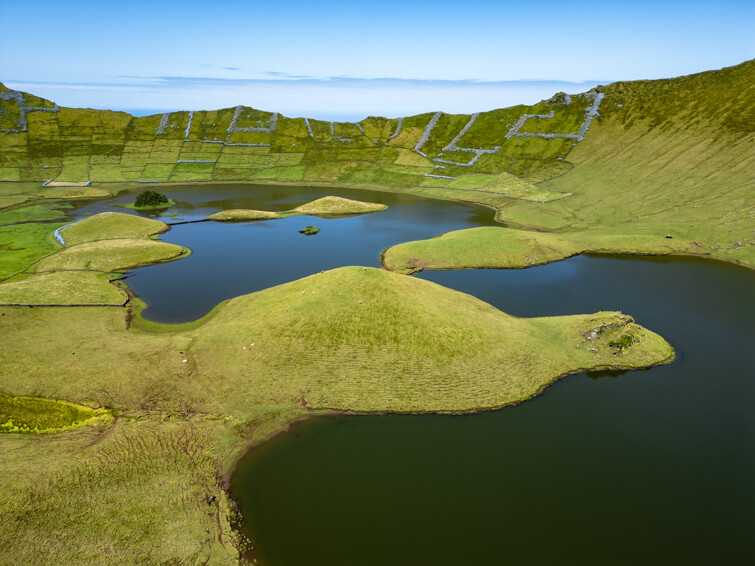
Hiking at Caldeirão in Corvo
There are two different hikes you can do at Caldeirão – one that takes you from the viewpoint down to the bottom of the crater and one that follows the rim of the crater.
The trail that descends to the bottom of the crater is the official PRC02 COR trail. It’s 4.8 km (3 mi) in length and takes about 2.5 hours to complete.
We decided to choose the other option – the trail along the rim of the crater – because I think the views from there are more impressive than those from the bottom. It’s an unofficial trail which starts at the large antennas near the viewpoint.
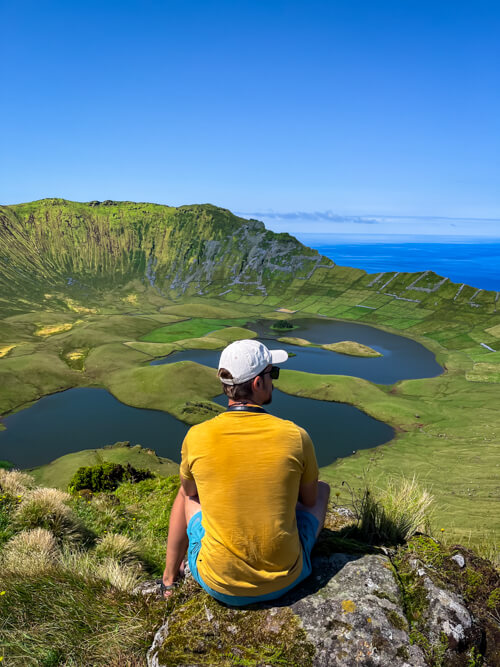
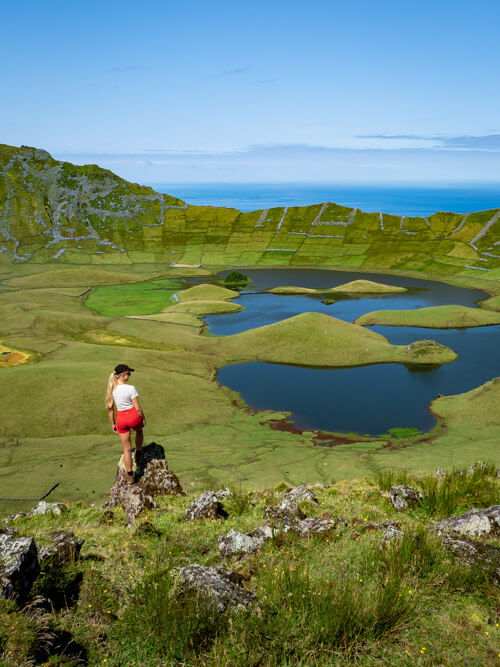
From the antennas, just continue walking along the rim. There’s no clear path but it’s impossible to get lost. The views are amazing the entire way but they are best from the northern part of the rim where the crater walls are especially steep.
We managed to hike about a third of the volcano’s rim (the northeastern portion) before turning back because we were running out of time and had to meet our taxi driver back at the start of the hike. Since it’s not an official trail, I haven’t been able to find information on how long it would take to hike the entire rim or what the trail conditions are like on the remaining portion of the hike.
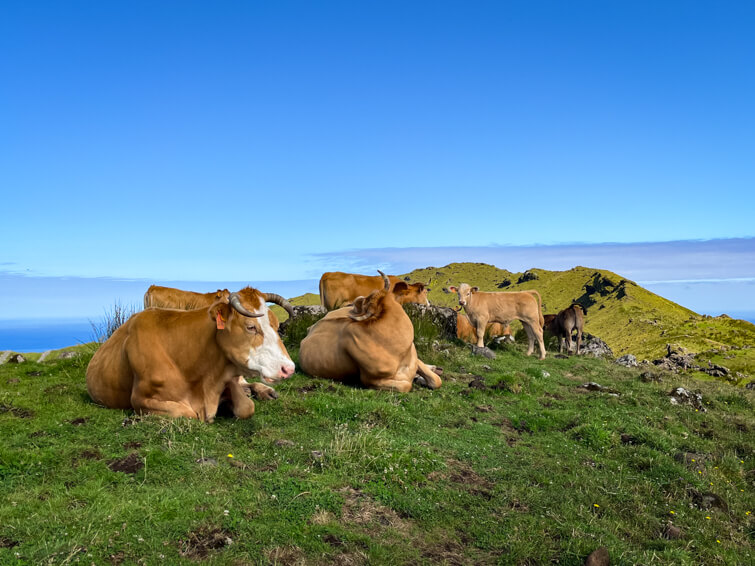
Whichever hike you choose, you can expect to see lots of cows at Caldeirão. Also, there are some rocky and muddy sections on either of these hikes, so I recommend wearing proper hiking shoes/boots. Be sure to bring some extra layers as well because it can often get windy and cold at Caldeirão due to its high elevation.
Be aware that Caldeirão is often covered with clouds and fog. For better views, try to visit it on a clear day.
Related post: Planning to do some hiking on São Miguel Island as well? Read my post on the 10 best hikes in São Miguel.
Other things to do in Corvo
1) Wander around Vila do Corvo
Aside from the obligatory visit to Caldeirão, you should also explore Vila do Corvo, the island’s only village. It’s characterized by cobblestone streets and small houses with white facades and terracotta roofs. It’s so tiny that it only takes 10 minutes to walk from one end to the other.
Take a stroll along its narrow alleyways, snap a photo with the big Corvo sign near the harbor, peek into the Church of Our Lady of Miracles and enjoy the view from the viewing platform near Casa do Tempo.
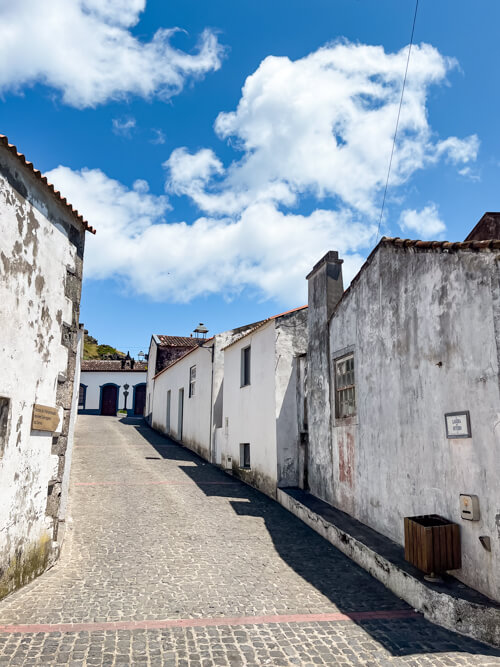
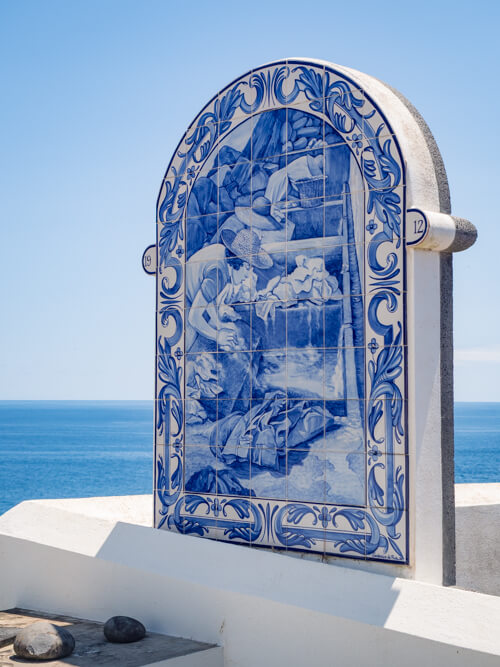
2) Hike the Cara do Indio trail
This is the official PR01 COR hiking trail. It’s a linear 10 km (6.2 mi) hike that starts at Caldeirão Viewpoint and ends at Praia da Areia beach near Vila do Corvo. The Cara do Indio trail leads through vast green pastures and offers great views of Vila do Corvo and Flores Island in the distance. It takes roughly three hours to complete this hike so it only makes sense to do it if you’re visiting Corvo for longer than just a day.
3) Relax at Praia da Areia
At the western end of Corvo’s airstrip, you’ll find the best beach on the island – Praia da Areia (Sand Beach). This small beach has black volcanic sand and clear water, and it offers a nice view of the cliffs on the west coast of Corvo. As the beach is surrounded by volcanic rocks that shelter it from big waves, the water here is calm and perfect for swimming.
If you decide to go for a dip, watch out for Portuguese man o’ war, a blue jellyfish-like animal with a painful sting.
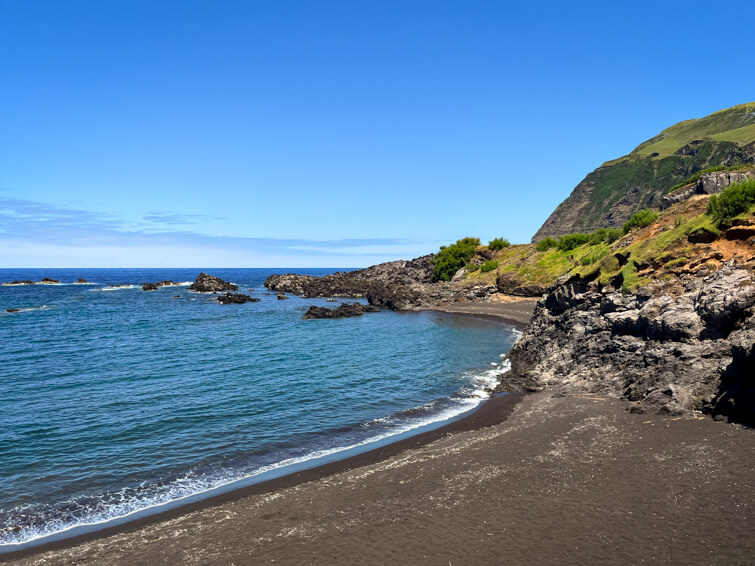
4) See the old windmills of Corvo (Moinhos do Corvo)
Just south of Corvo’s airstrip, there’s a waterfront area with three traditional windmills dating back to the 19th and 20th centuries. There you can also get a nice view of the Atlantic Ocean and Flores Island on the horizon.
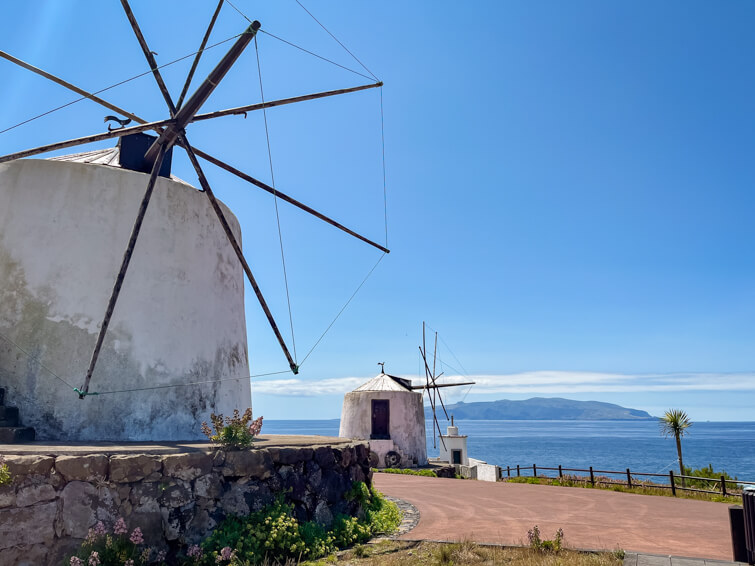
5) Visit Casa do Tempo – Ecomuseu do Corvo
The small Casa do Tempo museum in Vila do Corvo presents the geological history and cultural heritage of Corvo Island. You can learn about Corvo’s volcanic origin as well as the traditions and important milestones of the community living on the island. Entrance is free. The museum is closed on Mondays and Sundays.
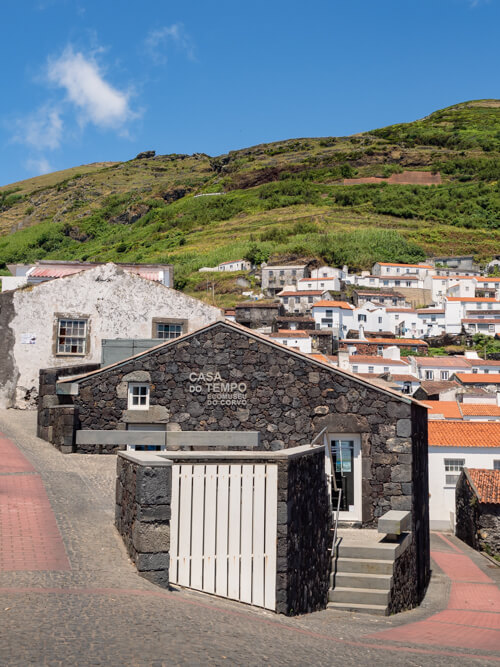
6) Take a dip at Porto da Casa
Porto da Casa is the port of Corvo, where boats dock when they arrive at the island. While a port might not sound like the most pleasant place to swim, the water here was incredibly clear and had the most beautiful vibrant turquoise color when we visited. Unfortunately, we didn’t have time to go for a dip here ourselves but we saw locals swimming here and doing backflips off the dock.
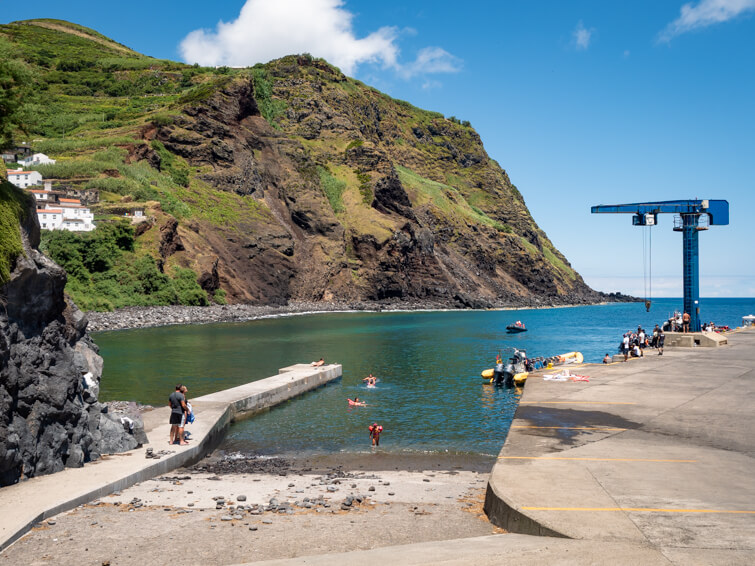
7) Go birdwatching
With its large number of bird species, both resident and migratory, Corvo is a haven for birdwatching. Due to the island’s location in the middle of the Atlantic Ocean, it’s an important stopover for migratory birds. October and November are especially popular months for birdwatching since that’s when many birds from the American continent migrate or stop here.
In Vila do Corvo, you’ll find Corvo Wild Birds Interpretation Centre (Centro de Interpretação de Aves Selvagens), where you can learn about Corvo Island Biosphere Reserve and the different bird species found on the island.
8) Take a boat tour around Corvo
If you’d like to explore the cliffs along the coast of Corvo and visit remote and untouched places only accessible by sea, you can take a boat tour around the island. The local tour operator Paralelo 39 offers this kind of tour.
How many days do you need
I recommend either taking a day trip to Corvo from Flores or spending one night there if you have the time. By taking a day trip, you will get to visit Corvo’s most impressive attraction Caldeirão, but you won’t have much time left for the other activities.
By spending a night or two in Corvo, you can experience the slow life of the island, explore more hiking trails and get to know the locals. Also, since the weather in Corvo (like anywhere in the Azores) is very unpredictable, having an extra day gives you a better chance of seeing Caldeirão without clouds and fog.
In my Azores itinerary post, I explain how to visit 3 islands in 10 days and how to plan your Azores trip in the most optimal way.
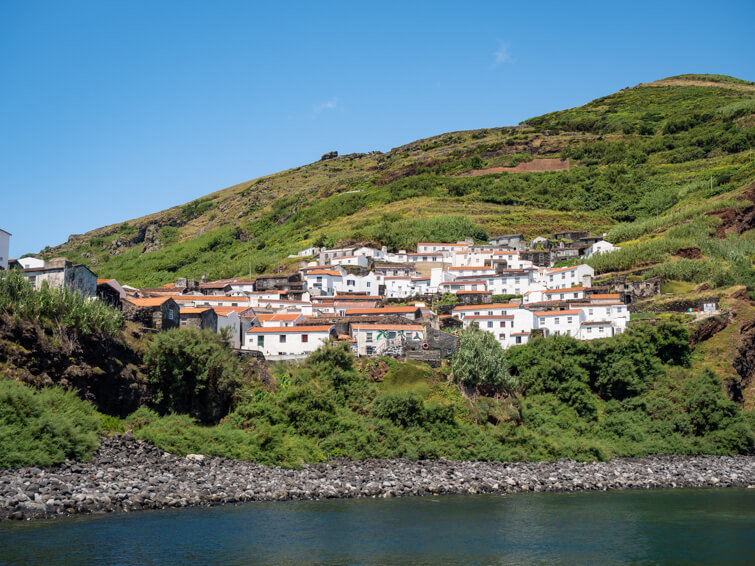
Where to stay in Corvo
Accommodation options in Corvo are very limited. If you want to stay there overnight, book your accommodation well in advance. You can choose between three different places to stay (plus a campsite):
Hotel Comodoro – The only hotel in Corvo. It’s a quiet, comfortable and unpretentious hotel with spacious rooms and beautiful views of the island.
Joe & Vera’s Villa – New and well-equipped cabins overlooking the sea. The minimum stay is two nights.
Joe & Vera’s Vintage – A guest house with comfortable rooms and delicious breakfast in the heart of Vila do Corvo.
If you’re interested in camping in Corvo, there’s a free public campsite next to Praia da Areia Beach. It’s very quiet and has hot showers, toilets and barbecue facilities. You can rent tents from Paralelo 39 near the port.
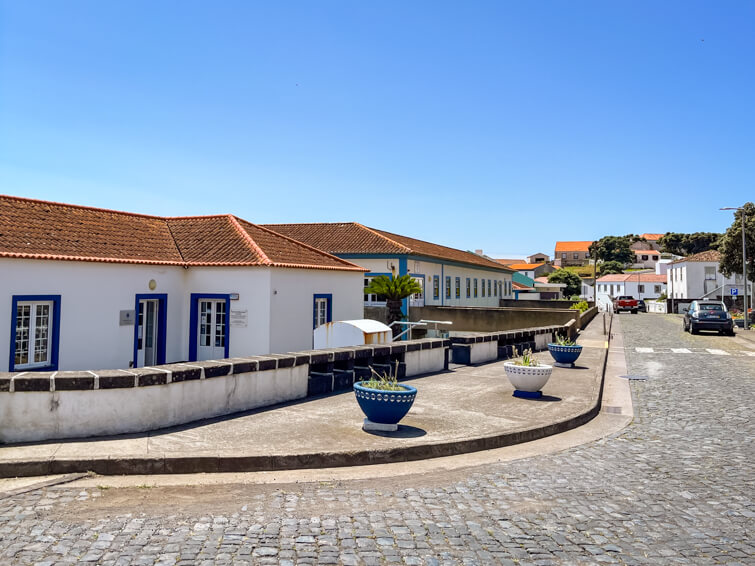
Where to eat in Corvo
Since Corvo is such a small and remote island with limited supplies, there are only a few restaurants and cafes to choose from:
Caldeirão Restaurante & Pastelaria – The biggest restaurant on the island. Here you’ll find a variety of food, including traditional Portuguese dishes. During lunchtime, they have a buffet whereas in the evening it’s à la carte.
Izzy Burger – This is where we ate. It’s a nice little food truck serving delicious burgers, sandwiches and pizza. They even had vegetarian options, which are not easy to find in Corvo.
BBC Caffé & Lounge – A simple restaurant and the only bar on the island, which apparently becomes pretty lively in the evenings.
O Manny Roulote – A food truck selling burgers, fries and pizza.
Snack Bar – Irmãos Metralha – A small restaurant serving traditional home-cooked food. They are open for dinner only and you have to make a reservation in advance.
Padaria do Corvo – The only bakery on the island. They have delicious bread and pastries and they’re open from 7 am to 12.30 pm.
Best time to visit Corvo Island
The best time of the year to visit Corvo is summer, from June to September. This is when you’ll have the best chance of clear blue skies and warm temperatures. July and August are the warmest and driest months but they are also the peak months for tourism. With that said, it never gets crowded in Corvo so I wouldn’t worry about that.
June to early September is also the period when you can see blue hydrangeas in bloom in Corvo (and the rest of the Azores). These beautiful flowers spread all across the mountainsides of Corvo, creating such a dreamy and idyllic ambience. You can even see them inside Caldeirão.
In the winter months (November to February), it rains frequently and it can be very windy. Flights often get cancelled and boat tours can’t take place due to weather conditions. Therefore, I don’t recommend traveling to Corvo in the winter.
Corvo has a humid subtropical climate but the weather can change very fast, especially at higher elevations. Whichever month you decide to visit Corvo, be prepared to experience all seasons in one day.
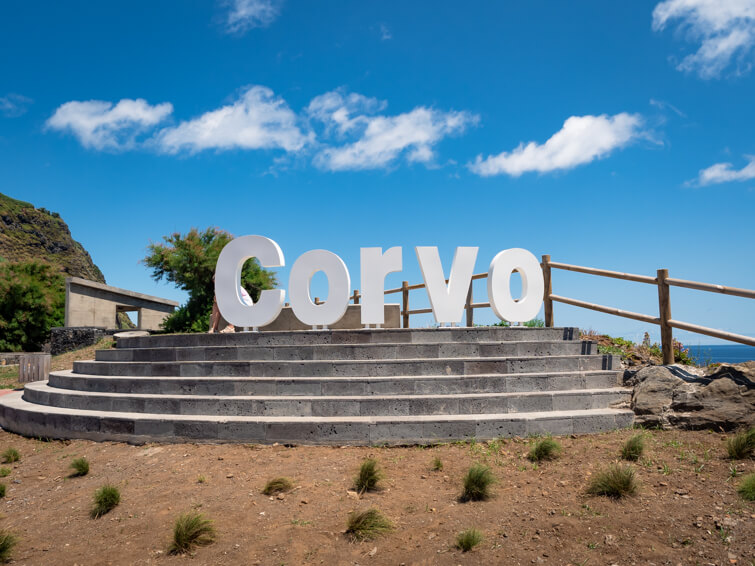
Corvo Island map
I always find it useful to see a map of the destinations I visit to get an idea of the layout of the place and where things are located. On the map below, I’ve marked all the points of interest that I covered in this Corvo travel guide. Click on the icon in the top left corner of the map for more details.
I hope this travel guide piqued your curiosity to visit Corvo Island and see the otherworldly Caldeirão with your own eyes. In case you have any questions about traveling to Corvo, leave them in the comments below and I’ll do my best to answer them.
Be sure to also read my other blog posts about Azores and Madeira for more travel inspiration and tips:
Pin this Corvo Island travel guide!
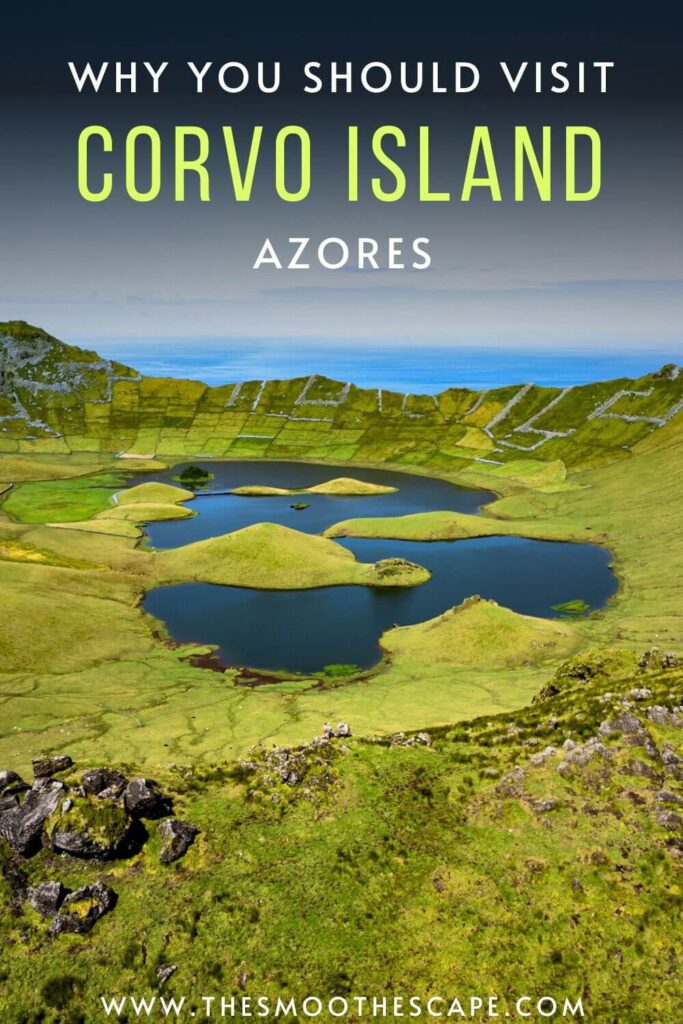
READ MORE:

